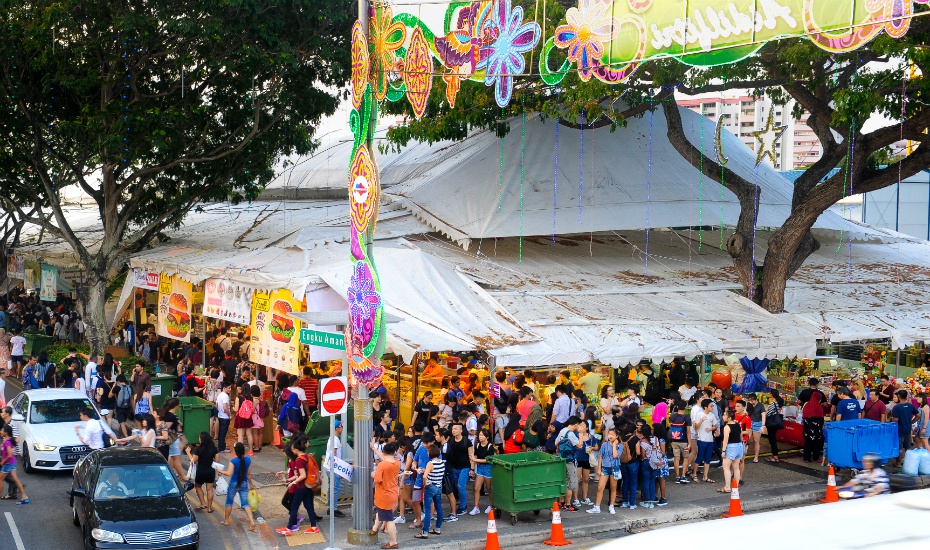
As the demand for customers heats up, stall owners are strategically positioning themselves away from the crowded Geylang Serai Ramadan Bazaar. This move allows them to attract more attention and potentially gain a larger share of the market. By setting up in alternative locations, these stall owners aim to differentiate themselves and offer unique offerings to their customers, thereby maximizing their chances of success during the Ramadan season.
In Singapore, some stall operators are opting not to rely solely on sales from the annual Geylang Serai Ramadan Bazaar this year, citing challenges in covering operational costs. For example, Stephen Suriyah, founder of The Original Vadai, has decided to rent two booths in one location instead of the four he occupied at various spots in the bazaar last year, despite the reduced rental costs this year.
The vadai shop owner is paying S$15,000 (US$11,000) per booth this year, which is approximately S$3,000 less than what he paid in 2023. Despite the reduced rental costs, he is hesitant to take up more space due to experiencing losses of over S$100,000 last year.
He explained that the low price of his items necessitates producing a large quantity to generate profit for the stall. “I’m selling (vadai) for about $1.30 cent per piece. So even if I sell 1,000, it’s only S$1,300. That doesn’t even cover my rental and manpower costing (per day) for this year,” he said. He noted that the situation differs for others who may sell items priced at S$10 each. “We really need to hit the quantity just to cover everything and make a little bit of profit.”
CHALLENGES FOR BUSINESSES
He plans to improve staffing at his booths to ensure customers don’t have to wait as long as the usual 45 minutes to get their snacks. Instead, he aims to serve them within 20 minutes.
Another challenge mentioned by businesses is that despite the high footfall – over 2 million visitors last year – it did not translate into sales.
This year, food and beverage stalls face a unique challenge: they are required to sell at least two budget items in their menu, capped at S$3. This measure aims to keep prices affordable and hopefully attract customers who have complained about expensive food items in the past.
The bazaar will be smaller this year, with 500 stalls compared to the 700 last year, due to ongoing development around the area, which has reduced available space.
MIX AT GEYLANG SERAI RAMADAN BAZAAR
According to Wisma Geylang Serai, more than 80 percent of the booths have been occupied. They mentioned that up to 60 percent of the food stalls offer traditional Hari Raya and Ramadan cuisine, while up to 80 percent of the retail stalls feature items associated with the festive theme.
One of the stalls selling traditional food at the bazaar is Boolatz Kitchen, which offers items like curry puffs, mee goreng, and tahu bergedil. Owner Farahdillah Mohd Zan, who has been running her home-based business since 2018, decided to return to the bazaar after her debut last year due to the positive reception she received. She mentioned that there were queues at the shop, indicating the popularity of her offerings.
“The older customers were waiting for us to open up,” she said, mentioning that she was able to cover last year’s S$17,800 rental within a week.
OPTING FOR OTHER BAZAARS
Mr. Suriyah’s strategy this year is to operate at just one location in Geylang and the rest in other areas like Woodlands, Tampines, and Kampong Glam.
“Nowadays, in almost every heartland area, there are bazaars. So people, I think for convenience’s sake, they are traveling down to all the heartland areas … to buy the food and then only during the last week or so, they’re coming to Geylang,” he noted.
Mr. Suriyah is not the only stall owner who has noticed that competition for customers has heated up as more Ramadan bazaars pop up in the heartlands, and popular spots like at Kampong Glam.
One entrepreneur is veering away from the Geylang Serai Ramadan Bazaar due to rental costs.
“I’m trying to picture myself renting the one in Geylang bazaar for S$12,000 or S$15,000 that’s offered to us. How much can we sell? How many sampings can we sell?” asked Ms. Ezreen Taib Zohri, co-founder of Band of Braders, which sells traditional Malay clothing called samping.
“We have to work extra hard to achieve that rent … and it doesn’t justify the essence of Ramadan in my opinion.”
One alternative bazaar that entrepreneurs like her are looking at is the upcoming one called “Celeb Raya” at SingPost Centre, which entrepreneur Fatimah Mohsin started organizing in 2017 along with other business owners.
Ms. Mohsin, who sells clothes, said the idea came about because typically, she would have to secure five booths to provide a comfortable space for her customers to try on outfits.
That would usually come up to around S$30,000 for rental at the Geylang Serai Ramadan Bazaar, which is too high, she said.
Vendors there are paying rent of between S$3,500 to S$12,000, depending on booth size.
While she hopes to keep products affordable for customers, she admitted that it comes with challenges as well.
“We try to reduce the cost of our rental … But shipping our products from overseas is costing us a bomb. It’s expensive and one of the challenges is also getting some newer vendors to join in because they have so many options,” she said.




